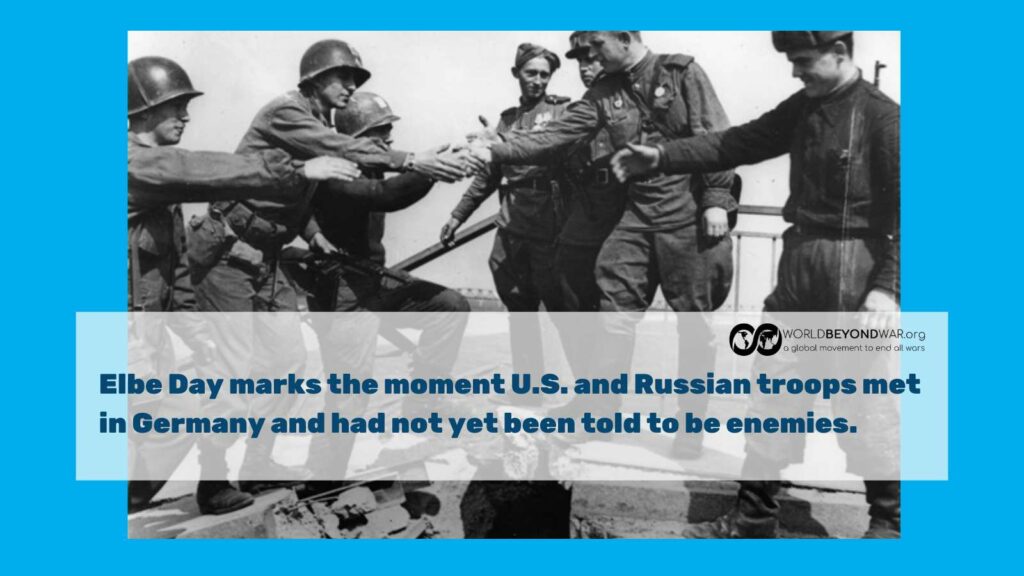
By Heinrich Buecker, Ana Barbara von Keitz, David Swanson, World BEYOND War, April 14, 2023
On April 22, 2023, Elbe Day will take place in Torgau, Germany.
Seventy-eight years ago, in April 1945, U.S. soldiers and Red Army soldiers met at the destroyed Torgau Elbe Bridge and made the “Oath on the Elbe”.
With a symbolic handshake, they sealed the approaching end of the war and the forthcoming destruction of fascism.
The peace rally and demonstration is not only intended to commemorate the past, but also to make an active contribution to the struggle for world peace today. What started out small in 2017 has now become a fixed date for peace activists across Germany. Last year, 500 people from 25 groups demonstrated for peace.
The demonstration starts on Saturday, April 22 at 12 noon at the bridgehead (flag monument on the east bank). Rallies are planned at the Thälmann monument and on the market square in Torgau.
The participants can look forward to speeches by Diether Dehm, Jane Zahn, Erika Zeun, Heinrich Bücker, Barbara Majid Amin, and Rainer Perschewski.
For some background on commemorations of this day, see this video:
The U.S. and Russian troops were allies and met as friends. Nobody had yet told them to be enemies. They didn’t know about Winston Churchill’s harebrained scheme to use Nazi troops to attack the Russians. They had not been told that as soon as the war was over the U.S. government would focus on its top enemy since 1917, the Soviet Union.
The allied governments had agreed that any defeated nation would have to surrender to all of them and completely. The Russians went along with this.
Yet, as WWII was ending, in Italy, Greece, France, etc., the U.S. and Britain cut Russia out almost completely, banned communists, shut out leftist resisters to the Nazis, and re-imposed rightwing governments that the Italians called “fascism without Mussolini.” The U.S. would “leave behind” spies and terrorists and saboteurs in various European countries to fend off any communist influence. NATO would be created as what it remains, a means of keeping the Russians out and the Germans down.
Originally scheduled for the first day of Roosevelt’s and Churchill’s meeting with Stalin in Yalta, the U.S. and British had bombed the city of Dresden flat, destroying its buildings and its artwork and its civilian population, apparently as a means of threatening Russia. The United States had developed and used on Japanese cities nuclear bombs, a decision driven largely by the desire to see Japan surrender to the United States alone, without the Soviet Union, and by the desire to threaten the Soviet Union.
Immediately upon German surrender, Winston Churchill proposed using Nazi troops together with allied troops to attack the Soviet Union, the nation that had just done the bulk of the work of defeating the Nazis. This was not an off-the-cuff proposal. The U.S. and British had sought and achieved partial German surrenders, had kept German troops armed and ready, and had debriefed German commanders on lessons learned from their failure against the Russians.
Attacking the Russians sooner rather than later was a view advocated by General George Patton, and by Hitler’s replacement Admiral Karl Donitz, not to mention Allen Dulles and the OSS. Dulles made a separate peace with Germany in Italy to cut out the Russians, and began sabotaging democracy in Europe immediately and empowering former Nazis in Germany, as well as importing them into the U.S. military to focus on war against Russia.
The war launched was a cold one. The U.S. worked to make sure that West German companies would rebuild quickly but not pay war reparations owed to the Soviet Union. While the Soviets were willing to withdraw from countries like Finland, their demand for a buffer between Russia and Europe hardened as the U.S.-led Cold War grew, in particular the oxymoronic “nuclear diplomacy.”
The repurcussions of this dramatically wasted opportunity for peace in the world are still with us and in fact are growing by the minute.









One Response
Wars make strange bedfellows. The “alliance of convenience” between the U.S. and the U.S.S.R. against the Third Reich has long ago dissolved. Today, a united Germany is a full member of NATO, while the Russian Federation, successor to the collapsed Soviet Union, is engaged in a War of Aggression against Ukraine, which had achieved independence under the 1994 Budapest Memorandum, under which it agreed to relinquish its nuclear arsenal in exchange for guarantees of sovereignty, territorial integrity and political independence, free from threats, or acts of force. While a united Germany has long ago been “DeNazified,” the Russian Federation has yet to renounce the “Molotov-Ribbentrop Pact, “under which Russia, along with the Third Reich, secretly agreed to divide Poland between them. Ukraine is engaged in a defensive war of necessity, exercising its “inherent right of individual, or collective self-defense,” as recognized under Article 51 of the United Nations Charter.